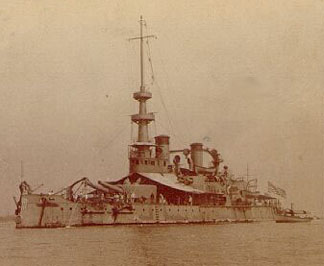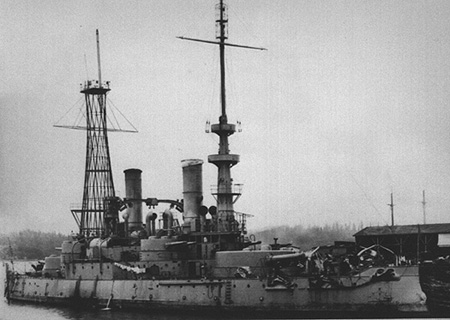After the Spanish-American War ended, the USS Oregon returned with the rest of the victorious fleet to the United States, the object of national pride and representing the growing American strength at home and abroad. People flocked to walk the decks of the proud warrior when she arrived in New York. Most importantly though, she received a much needed overhaul while in New York. The cruise around South America and the months of duty in the waters off of Cuba had fowled the hull of the Oregon with barnacles and sea growth. Her stay in New York would not last long though. Duty would soon call again.
The United States, new to the arena of empire building, was already having difficulties with the newly acquired Philippine Islands which was won from the Spanish. Admiral Dewey, the hero of the Battle of Manila Bay, requested reinforcements, in the form of the USS Oregon. The Navy Department granted the request.
 The Oregon got underway
for the Pacific on October 12, 1898 in company with the battleship
USS Iowa, a supply ship, the Celtic, a distilling
ship, the Iris, and a collier, the Scindia. The
route taken was a near reverse image of the Oregon's lone
dash to the Atlantic less than a year ago, but not at the frantic
pace. Stops in Rio de Janeiro, Brazil, and Callao, Peru were made
and the Americans were greeted warmly.
The Oregon got underway
for the Pacific on October 12, 1898 in company with the battleship
USS Iowa, a supply ship, the Celtic, a distilling
ship, the Iris, and a collier, the Scindia. The
route taken was a near reverse image of the Oregon's lone
dash to the Atlantic less than a year ago, but not at the frantic
pace. Stops in Rio de Janeiro, Brazil, and Callao, Peru were made
and the Americans were greeted warmly.
Upon departing Peru, the small fleet split up, with Iowa heading to San Francisco. The Scindia and Celtic had already departed earlier which left Oregon and Iris to make the trip to the Philippines. Once again the Oregon performed superbly on the long cruise, and upon arriving in Manila on March 18, 1899, she received a resounding hail from Dewey's fleet.
Above: USS Oregon at anchor shortly after arriving in the Philippines to reinforce Adm. Dewey's fleet. The Oregon at that time was the most powerful ship in Asia.
Dewey was elated to have the battleship in his fleet which consisted mainly of cruisers including the USS Olympia, of which he transferred his flag from, to Oregon. He now had sufficient strength to conduct operations during the Philippine insurrection. During the insurrection, Oregon provided transport and gunfire support, but more importantly, protected U.S. interest in the region. Dewey had the only battleship in the region, and this provided the necessary deterrent to the other colonizing foreign powers in the area such Germany. By the presence of one ship, the whole balance of power was shifted overnight.
The Philippines Islands were not the only difficulties the Americans had. Problems soon broke out in China as the Chinese people rebelled against its corrupt government in what was know as the Boxer rebellion. The Oregon was detached from duty in the Philippines to support the American presence in China.
After departing Hong Kong on June 23, 1900, the Oregon proceeded to the port city of Taku, near Peking. Under orders to make port at best speed, Captain Wilde chose the shortest route. On June 28, Wilde decided to anchor after his ship was engulfed in a dense fog. As the weather cleared up the next day, Wilde put boats over to take depth soundings and they reported a little over 5 fathoms in the channel to the east. The Oregon started to get underway for port when the ship hit Pinnacle Rock, a twenty five foot high underwater obstruction. Immediate repairs were made but a dock was needed to correct the damage done to the hull. Three days after the grounding, the Oregon was refloated and proceeded to the Japanese naval base at Kure, Japan. Repairs were effective, but more permanent repair work was needed in order to return the ship to full duty. The Oregon prepared to sail home to her place of origin: San Francisco.
When the people of San Francisco heard the ship was returning, the city prepared a celebration for the ship and her crew. Unfortunately, for the planners of the celebration, Oregon was still the fastest American ship around and arrived one day early. Despite the early arrival, the celebration went on. The battleship then proceeded to Bremerton, Washington for a full refit.
1902 found the Oregon in the waters of the Pacific and again off the coast of China as the situation continued to deteriorate. For four years, the Oregon "showed the flag", steaming up and down the coast of China in support of United States policies. Finally, early in 1906, the Oregon would be able to come home for a much needed rest. She was decommissioned in April of 1906 at the Bremerton Navy Yard. The Oregon remained in Bremerton in ordinary for about five years receiving upgrades and modifications in an attempt to keep her modern. The ship was recommissioned on August 29, 1911, with Captain Charles Pond commanding. Oregon operated out of San Diego, California for the next few years and then was placed in reserve status in 1914 at the Bremerton Navy Yard.
The Oregon was placed once again in full commission on January 2, 1915 and sailed to San Francisco to participate in the Panama-Pacific International Exposition. The USS Oregon was of immense interest while at the exposition as thousands visited the ship while in port. After this, the battleship was placed in reserve once again.
On April 6, 1917, the United States of America formally entered World War I with a declaration of war on Germany. One day later, the Oregon was placed in full commission and modernized. Once again the "Bulldog" was at war. More modern and capable battleships were serving on the "frontlines", so the USS Oregon served as a training ship, training officers and enlisted men for duty in the European combat zone. In this capacity, Oregon also served as the Pacific Fleet flagship, but was soon assigned a wartime, although lesser known, mission. The Oregon was selected to escort transports to the Russian port of Vladivostok in Siberia.

Above photo: USS Oregon in unknown North American port either Portland or Bremerton, Washington. Note the newly added cage mast aft.
Courtesy: Eugene Naval and Marine Corps Reserve Center, Eugene, Oregon
A multi-national force was formed, including a couple thousand American troops, to journey to Siberia. The role of expeditionary force was to prevent war supplies intended for Russia, from falling into German hands. But the actual goal of the expedition was to assist the White Russian counterrevolutionaries. The USS Oregon provided escort and cover for the transports of the expedition. Ultimately, the expedition was unsuccessful and the multi-national force withdrew. The Oregon proceeded home.